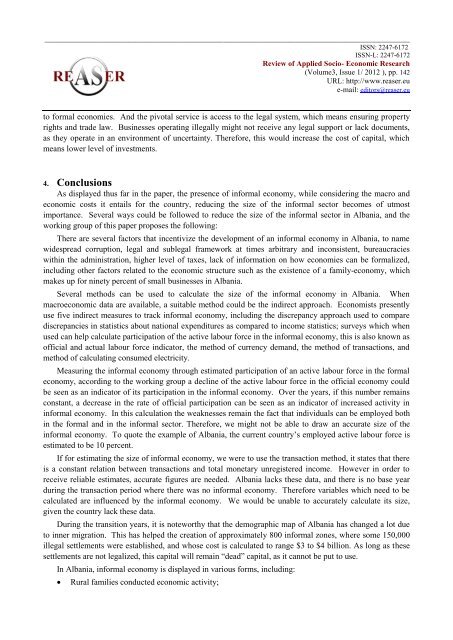Volume 3, ISSUE1/2012 - Review of Applied Socio-Economic ...
Volume 3, ISSUE1/2012 - Review of Applied Socio-Economic ...
Volume 3, ISSUE1/2012 - Review of Applied Socio-Economic ...
You also want an ePaper? Increase the reach of your titles
YUMPU automatically turns print PDFs into web optimized ePapers that Google loves.
________________________________________________________________________________________________<br />
ISSN: 2247-6172<br />
ISSN-L: 2247-6172<br />
<strong>Review</strong> <strong>of</strong> <strong>Applied</strong> <strong>Socio</strong>- <strong>Economic</strong> Research<br />
(<strong>Volume</strong>3, Issue 1/ <strong>2012</strong> ), pp. 142<br />
URL: http://www.reaser.eu<br />
e-mail: editors@reaser.eu<br />
to formal economies. And the pivotal service is access to the legal system, which means ensuring property<br />
rights and trade law. Businesses operating illegally might not receive any legal support or lack documents,<br />
as they operate in an environment <strong>of</strong> uncertainty. Therefore, this would increase the cost <strong>of</strong> capital, which<br />
means lower level <strong>of</strong> investments.<br />
4. Conclusions<br />
As displayed thus far in the paper, the presence <strong>of</strong> informal economy, while considering the macro and<br />
economic costs it entails for the country, reducing the size <strong>of</strong> the informal sector becomes <strong>of</strong> utmost<br />
importance. Several ways could be followed to reduce the size <strong>of</strong> the informal sector in Albania, and the<br />
working group <strong>of</strong> this paper proposes the following:<br />
There are several factors that incentivize the development <strong>of</strong> an informal economy in Albania, to name<br />
widespread corruption, legal and sublegal framework at times arbitrary and inconsistent, bureaucracies<br />
within the administration, higher level <strong>of</strong> taxes, lack <strong>of</strong> information on how economies can be formalized,<br />
including other factors related to the economic structure such as the existence <strong>of</strong> a family-economy, which<br />
makes up for ninety percent <strong>of</strong> small businesses in Albania.<br />
Several methods can be used to calculate the size <strong>of</strong> the informal economy in Albania. When<br />
macroeconomic data are available, a suitable method could be the indirect approach. Economists presently<br />
use five indirect measures to track informal economy, including the discrepancy approach used to compare<br />
discrepancies in statistics about national expenditures as compared to income statistics; surveys which when<br />
used can help calculate participation <strong>of</strong> the active labour force in the informal economy, this is also known as<br />
<strong>of</strong>ficial and actual labour force indicator, the method <strong>of</strong> currency demand, the method <strong>of</strong> transactions, and<br />
method <strong>of</strong> calculating consumed electricity.<br />
Measuring the informal economy through estimated participation <strong>of</strong> an active labour force in the formal<br />
economy, according to the working group a decline <strong>of</strong> the active labour force in the <strong>of</strong>ficial economy could<br />
be seen as an indicator <strong>of</strong> its participation in the informal economy. Over the years, if this number remains<br />
constant, a decrease in the rate <strong>of</strong> <strong>of</strong>ficial participation can be seen as an indicator <strong>of</strong> increased activity in<br />
informal economy. In this calculation the weaknesses remain the fact that individuals can be employed both<br />
in the formal and in the informal sector. Therefore, we might not be able to draw an accurate size <strong>of</strong> the<br />
informal economy. To quote the example <strong>of</strong> Albania, the current country’s employed active labour force is<br />
estimated to be 10 percent.<br />
If for estimating the size <strong>of</strong> informal economy, we were to use the transaction method, it states that there<br />
is a constant relation between transactions and total monetary unregistered income. However in order to<br />
receive reliable estimates, accurate figures are needed. Albania lacks these data, and there is no base year<br />
during the transaction period where there was no informal economy. Therefore variables which need to be<br />
calculated are influenced by the informal economy. We would be unable to accurately calculate its size,<br />
given the country lack these data.<br />
During the transition years, it is noteworthy that the demographic map <strong>of</strong> Albania has changed a lot due<br />
to inner migration. This has helped the creation <strong>of</strong> approximately 800 informal zones, where some 150,000<br />
illegal settlements were established, and whose cost is calculated to range $3 to $4 billion. As long as these<br />
settlements are not legalized, this capital will remain “dead” capital, as it cannot be put to use.<br />
In Albania, informal economy is displayed in various forms, including:<br />
<br />
Rural families conducted economic activity;








